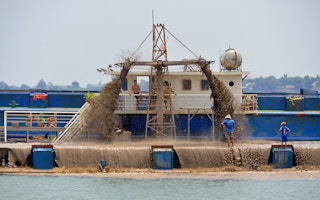Japan’s government lobbied hard for a global pact that limits mercury use and to name the resulting treaty after Minamata, the site of a homegrown industrial disaster from the 1950s when the toxic metal poured into a river, poisoning thousands.
But a year after the Minamata Convention on Mercury was agreed in southwestern Japan, Japanese industries from smelters to cement makers are digging in to fight storage costs and emission curbs the still-pending treaty would impose.
The international pact, so far only ratified by the United States as other nations take time to iron out domestic regulations, would require countries to ban nearly all exports of the poisonous material.
Industry pressure in Japan could prevent the government doing much more than the bare minimum to comply with the treaty’s legal framework, leaving the door open to at least some mercury exports from the country and weakening the global crackdown on the metal’s use.
At issue is how far Japan will go under the more business-friendly Liberal Democratic Party of Prime Minister Shinzo Abe toward shutting down a system that has made its economy Asia’s largest net exporter of the material, typically churned out as a by-product.
If Japan’s mercury exports are scaled back to virtually nothing as proposed, industries will need to secure disposal sites for tonnes of the poisonous metal in an earthquake-prone country where storing hazardous waste has become an especially fraught issue since the Fukushima nuclear crisis.
Japan’s effort to play a leading role in the international drive to curb mercury use dates back to 2010 when the now-opposition Democratic Party of Japan was in power, pushing an image of the country as a green powerhouse.
But unlike the United States and the European Union, Japan has not unilaterally banned exports of mercury, widely used in small-scale gold mining operations in developing economies such as Indonesia and linked to environmental and health risks. That was largely due to worries over storage.
“Our top priority is to make and change laws so that we can comply with the treaty,” said Shuji Tamura, head of chemical substance control at Japan’s trade ministry.
“
What I’m most afraid about is seeing a rise in illegal dumping of mercury due to higher disposal fees
Yasushi Fujiwara, president of Nomura Kohsan
Debate on storage and issues such as the investment needed to reduce mercury emissions by coal-fired power plants, waste incineration plants and cement factories is taking shape in three government advisory panels due to submit recommendations by year-end. Legislation is expected to be introduced as early as 2015.
Industry advocates
The Japan Mining Industry Association, which represents big smelters like JX Nippon Mining & Metals, a unit of JX Holdings Inc, and Sumitomo Metal Mining in July asked the government for a limited change to current regulations.
One government panel estimates Japan would need to secure total storage space equivalent to around the size of an Olympic swimming pool for mercury waste collected over 50 years if it limits exports.
That assumes Japan would keep recycling about 50 tonnes of the metal each year as it did in 2010, using that mercury in items such as fluorescent lights.
With the chance that storage could be dotted around the country, industry lobbyists say convincing local communities to host disposal sites would be a major challenge in one of the world’s most seismically active regions.
Japan’s government expects to spend up to $20 billion to build storage facilities for radioactive waste from the 2011 nuclear disaster.
“No one wants to even talk about mercury disposal facilities,” said Yasushi Fujiwara, president of Nomura Kohsan, a firm that once operated one of Asia’s biggest mercury mines. The company has emerged as the hub of Japan’s mercury trade, and is its only specialist in recycling the metal.
Japan’s net mercury exports were 69 tonnes in 2012, higher than any other country in Asia and worth about $6 million, according to the United Nations.
That climbed to 73 tonnes last year, but comparative figures are not available for the whole region.
Nomura Kohsan expects to be put in charge of mercury storage in Japan, but warns that imposing high costs could backfire.
“What I’m most afraid about is seeing a rise in illegal dumping of mercury due to higher disposal fees,” Fujiwara said.
Steel exemption?
Japan’s steel industry is also lobbying against broad emission regulations that would push up its costs.
Steel plants were responsible for 25 per cent of Japan’s mercury emissions in 2010, second only to cement factories, government data shows.
The Minamata treaty requires the cement industry to cut emissions but not steel producers, although some members of one government panel are expected to push for steelmakers to take measures such as installing filtering equipment.
The cement industry, which uses steel slag and ash from coal-fired power plants containing mercury as raw materials, also asked the panel last month to set rules that will not impose an “excessive burden”.
The Minamata treaty aims to reduce the use of mercury in small-scale gold mining in Asia, South America and Africa. The metal is used in small mines to separate gold from ore, creating toxic fumes and polluting soil and river systems.
In the Minamata case, a chemical company dumped mercury into a river. The Japanese government recognizes 2,265 people as Minamata disease victims, with symptoms including brain damage and birth defects.
The pact will take effect after it has been ratified by 50 nations, something expected in 2016 at the earliest.
“Since the Minamata treaty provides only a minimum global standard which developing countries can comply with, it is not that difficult for developed countries, including Japan, to meet requirements,” said Yukari Takamura, professor at the Graduate School of Environmental Studies at Nagoya University.
“The issue is whether Japan, which has experienced Minamata disease, will do more than that.”

















